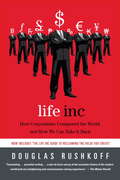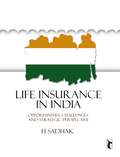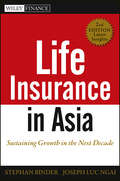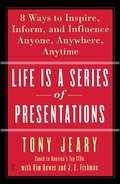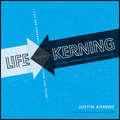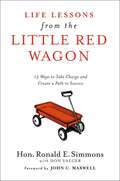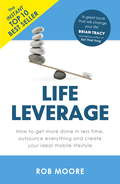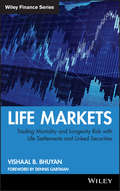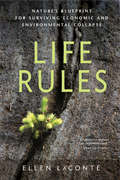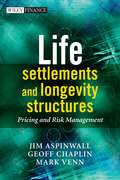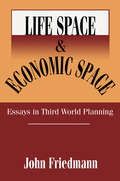- Table View
- List View
Life Inc.: How The World Became a Corporation and How to Take It Back
by Douglas Rushkoff* Something has gone terribly wrong. We are deep in the thrall of a system that no one really likes, no one remembers asking for, yet no one can escape. It just is. And the minute it seems as if we can put our finger on what's happening to us or how it came to be this way, the insight disappears, drowned out by the more immediately pressing demands by everyone and everything on our attention. What did they just say? My phone is vibrating . * In Life Inc Douglas Rushkoff offers a timely, provocative and urgent look at the origins and nature of the modern corporate system, a world in which everything can be commodified, a closed system that conquers not through exclusion but total inclusion. Under current conditions market forces have achieved a nightmarish triumph everything, including dissidence, is assimilated. * Life Inc tells the story of how we got here and, more importantly, how this value system now perpetuates itself. Rushkoff reveals the process through which media conglomerates conceive and assimilate everything from teen icons to online communities, and replace anything resembling civic engagement with yet another consumer choice. His goal is nothing less than to give us the view from outside of the hermetically sealed shopping mall in which we spend our lives.
Life Insurance In India: Opportunities, Challenges and Strategic Perspective (Response Books)
by Hira SadhakThis first-of-its-kind book reflects on life insurance in the current context of globalization and economic reforms and traces the interdependence of life insurance and macro economic factors. It focuses on structural change, market potential and emerging challenges for the Indian Life Insurance industry and also covers the global life insurance industry, regulatory regime, and market friendly practices abroad. Thus it provides a powerful insight into emerging trends in the Life Insurance industry as a whole. Life Insurance in India: Opportunities, Challenges and Strategic Perspective presents a detailed analysis of several strategic and managerial issues such as product-market relationship, distribution, marketing strategies and funds management and focuses specially on the changing contours of risk management in life insurance. Primary concerns for the post-liberalized industry like structural changes in economy and financial sectors, information explosion, need for competitive management efficiency, etc., have been discussed with suggestive guidelines. A supplement on analysis of macro economic indicators and their impact on stock market investment make this book a ready manual for any practicing manager. Apart from the general reader, it will also be very useful for regulators and students of Insurance Management and training programmes of Life Insurance companies.
Life Insurance in Asia
by Joseph Luc Ngai Stephan BinderAn incisive look at the war for market share in the Asian life insurance marketAlthough the life insurance industry in Asia has emerged from the financial crisis stronger than ever, it has not escaped unchanged. As the general focus of insurance companies across the continent moves towards profitability beyond growth, tightening regulatory measures, shifts in consumer preferences, and risk tolerance, battle lines have been drawn between local incumbents, attackers, and foreign players. Life Insurance in Asia: Winning in the Next Decade, Second Edition looks at the ways in which small local agencies and multinational companies alike are seizing control of as much of the market as they can by aggressively recruiting new agents, leveraging new channels, and selling new products to cash in on the explosive Asian markets.Thoroughly revised and updated, this new edition offers a comprehensive introduction to the booming Asian life insurance markets and outlines exactly what it takes to capture the opportunities that are emerging. Drawing on the research and experience of the McKinsey Asia financial services team, it includes everything you need to know about the battle for the life insurance market in Asia.Looks at how China and India are becoming increasingly important players on the international life insurance sceneGoes behind the scenes of the Asian life insurance industry and the contentious battle for market shareOutlines the steps to successfully entering, and prospering, in the Asian marketThe life insurance industry in Asia is changing like never before. What the future holds, no one knows, but with Life Insurance in Asia in hand, you'll have a clear idea of the factions in play and the rules of the game.
Life Insurance in Europe: Risk Analysis and Market Challenges (Financial and Monetary Policy Studies #50)
by Simon Grima Marta Borda Ilona KwiecieńThis book examines the challenges for the life insurance sector in Europe arising from new technologies, socio-cultural and demographic trends, and the financial crisis. It presents theoretical and applied research in all areas related to life insurance products and markets, and explores future determinants of the insurance industry’s development by highlighting novel solutions in insurance supervision and trends in consumer protection. Drawing on their academic and practical expertise, the contributors identify problems relating to risk analysis and evaluation, demographic challenges, consumer protection, product distribution, mortality risk modeling, applications of life insurance in contemporary pension systems, financial stability and solvency of life insurers. They also examine the impact of population aging on life insurance markets and the role of digitalization. Lastly, based on an analysis of early experiences with the implementation of the Solvency II system, the book provides policy recommendations for the development of life insurance in Europe.
Life Is a Series of Presentations: 8 Ways to Punch Up Your People Skills at Work, at Home, Anytime, Anywhere
by Tony Jeary Kim Dower J. E. FishmanPresentation Mastery Is the Key to Professional and Personal Success. As presentation coach to America's top CEOs, Tony Jeary has become known as Mr. Presentation . In his work with more than 500 world-class organizations in 35 countries, he has found a common denominator in every situation: Your success in life depends upon how you approach the millions of opportunities before you. And in this insightful and compelling book, Jeary reveals the eight simple secrets that you can put to work immediately to achieve dramatic results both at work and at home -- and everywhere else! Unless you're a hermit living on a mountaintop, your life largely consists of your interactions with the people around you. Whether you call them presentation skills or people skills, these eight essential practices will allow you to master any interaction, whether it involves a roomful of colleagues, a small group, or just one other person. You will learn to understand both why the eight essentials work as well as how they work, including: the single word that will convince 93 percent of your listeners every time the big question presenters consistently forget to ask themselves the 10 personality types you must be able to recognize and handle the firepower of your own Presentation Arsenal the magic behind the mnemonic I P R E S E N T. Engaging, informative, and loaded with useful anecdotes, this book will teach you easy-to-use skills that change the way you approach every situation and that will have an immediate impact on you, both professionally and personally. Because your life is a series of presentations.
Life Is a Startup: What Founders Can Teach Us about Making Choices and Managing Change
by Noam WassermanAfter two decades of research on founders, a best-selling book on the subject, and experience teaching and mentoring thousands of students in this field, Noam Wasserman is a prominent authority on startups. Hearing from countless readers and students that his insights helped them with important life decisions, beyond the incubator and boardroom, Wasserman brings us a new book that applies to everyday life his research on the methods of successful startup founders. Like entrepreneurs, we all deal with uncertainty, tough decision-making, and necessary problem-solving. Whether we freelance or work for large organizations, whether we're married or single, have kids or not, we must be able to think on our feet, assess risks and opportunities, and recruit others to help us navigate them. This book offers important advice for envisioning change in our lives—from contemplating the next step in a relationship to making a radical career move—and managing changes to which we've already committed. We can learn to recognize our own well-worn patterns and keep our tendencies and habits in check, recruit a personal taskforce—our own board of directors—to advise us, and plan ahead for growth. With his extensive database of entrepreneurship case studies—from Pandora to Twitter to Nike—complemented with data on 20,000 founders, Wasserman is able to go deeply into the entrepreneurial mindset and show us how startups provide specific lessons for crafting our most successful lives.
Life Kerning
by Justin AhrensCreative approaches for designing a more balanced life and careerIn the graphic design industry, kerning is the fine-tuning or adjustment of space between letterforms (type). In this book, author Justin Ahrens applies this concept to both the life and career of business professionals. There is a common misconception that positive change in one's life only comes from a complete system overhaul. Ahrens challenges this notion by inviting business leaders and professionals to not only reassess the various spaces and goals of one's life, but to rethink our understanding of balance altogether.This book includes insights and observations from both the creative and professional world.Guides you in determining what you're passionate about, and how to keep those passions in the forefront of your life and careerHow to create work that stands apartHow to cultivate and maintain a group of wise mentorsDevelop critical decision-making skillsLive a life that fuels your work, and work in a way that fuels your life. Life Kerning shows you how.
Life Lessons for Lawyers: Guidance for the Mind and Soul
by Ray SteinwallThis book draws on the author’s professional experience and published works in the areas of leadership, philosophy, psychology and management (amongst others) to discuss the ‘softer’ qualities of being a good lawyer – qualities which are not taught or widely documented, such as humility, confidence, personal relationships and our dreams and vision.The book demonstrates that we can be individuals within the law and outlines qualities that can both enrich our work and our souls. A theme throughout many of the chapters is to encourage us to think and act differently to what we may have been taught, what others expect or what we ourselves believe. To know that regardless of our strengths and weaknesses, we are unique individuals in the law. This book offers wisdom and pragmatic support for lawyers and anyone involved with the law.Covering a range of issues, it includes advice on: • Maintaining one’s passions inside and outside law • Dealing with perfectionist tendencies, anxiety and depression • Manging our fears and dealing with mistakes • Striving for an honourable path • Understanding and leveraging the organisational matrix • Acting as a moral voice in your organisation • Leading with humility and vulnerability • Taking breaks and reconnecting with ourselves • Navigating structural inequalities in one’s career.This book is an easy must-read for anyone seeking advice on how to succeed in law.
Life Lessons for Women
by Jack Canfield Mark Victor Hansen Stephanie MarstonJack Canfield and Mark Victor Hansen have inspired millions with their timeless tales of everyday life. Now they team with noted women's issues expert Stephanie Marston in Chicken Soup for the Soul: Life Lessons for Women.Extraordinary recipes for living will improve lives in nine simple steps. Women will benefit from getting to know themselves in a journal that truly celebrates life. The basic premise of the Chicken Soupseries--the power of friendship, the joy of the small moment, and importance of relationships--has been reborn into a step-by-step primer for a better life. The advice in Life Lessons is aimed specifically at women and their everyday concerns, such as finding time, making ends meet, and balancing priorities; it is straightforward yet perceptive, and combined with powerful stories, it overflows with inspiration and direction for creating a significant life.
Life Lessons from the Little Red Wagon: 15 Ways to Take Charge and Create a Path to Success
by Hon. Ronald E. SimmonsWho would have thought that one of the most popular childhood toys held so many of life&’s answers.In The Little Red Wagon, prolific business leader and public servant Ron Simmons invites you to leave ordinary behind and glide into the richly meaningful life you were intended to live. From his humble beginnings in the rural South to the heights of influence as an entrepreneur, finance executive, and three-term member of the Texas House of Representatives, Simmons mines the depths of his triumphs and travails to provide a wealth of applicable insights. Whether you&’re out front holding the wagon&’s handle, shifting the direction from inside, riding along as cargo, or pushing from the rear, the place you occupy will set your course toward more of the same or to bold adventure. Simmons has learned that it isn&’t a lack of talent or ability that often holds us back. It&’s the lure of the safe, comfortable path that threatens to keep us stuck in a rut of fear and negativity, speeding along with no clear destination, or passively catching a ride instead of taking initiative and action.
Life Leverage: How to Get More Done in Less Time, Outsource Everything & Create Your Ideal Mobile Lifestyle
by Rob MooreYou are just one small step away from the life you know you deserve. It's time to leverage your life.Life Leverage means taking control of your life, easily balancing your work and free time, making the most money with the minimum time input & wastage, and living a happier and more successful life.Using Rob Moore's remarkable Life Leverage model, you'll quickly banish & outsource all your confusion, frustration and stress & live your ideal, globally mobile life, doing more of what you love on your own terms.Learn how to:- Live a life of clarity & purpose, merging your passion & profession- Make money & make a difference, banishing work unhappiness- Use the fast-start wealth strategies of the new tech-rich- Maximise the time you have; don't waste a moment by outsourcing everything- Leverage all the things in your life that don't make you feel alive'This book shows you how to get more done, faster and easier than you ever thought possible. A great book that will change your life'. Brian Tracy, bestselling author of Eat That Frog
Life Leverage: How to Get More Done in Less Time, Outsource Everything & Create Your Ideal Mobile Lifestyle
by Rob MooreYou are just one small step away from the life you know you deserve. It's time to leverage your life.Life Leverage means taking control of your life, easily balancing your work and free time, making the most money with the minimum time input & wastage, and living a happier and more successful life.Using Rob Moore's remarkable Life Leverage model, you'll quickly banish & outsource all your confusion, frustration and stress & live your ideal, globally mobile life, doing more of what you love on your own terms.Learn how to:- Live a life of clarity & purpose, merging your passion & profession- Make money & make a difference, banishing work unhappiness- Use the fast-start wealth strategies of the new tech-rich- Maximise the time you have; don't waste a moment by outsourcing everything- Leverage all the things in your life that don't make you feel alive'This book shows you how to get more done, faster and easier than you ever thought possible. A great book that will change your life'. Brian Tracy, bestselling author of Eat That Frog
Life Markets
by Vishaal BhuyanA complete guide to longevity finance As the Baby Boomer population continues to age and the need for the securitization of life insurance policies increases, more financial institutions are looking towards longevity trading as a solution. Consequently, there is now a need for innovative financial products and strategies that have the ability to hedge longevity exposure for pension funds, reinsurance companies, and governments. These products and strategies are currently being developed with the use of life settlements. Here, author Vishaal Bhuyan provides a complete guide to this burgeoning sector. In Life Markets, Bhuyan and a team of expert contributors from leading firms offer an extensive look at how to trade life settlements. Provides practical guidance to the growing field of longevity finance Outlines the innovative financial products that are populating this field Highlights a safe haven for investors seeking returns in troubled times Covering everything from the history of life settlements to making a transaction-pricing, service providers, exchanges, and more-this book contains extensive coverage of the many issues surrounding longevity finance.
Life Rules
by Ellen LaconteCorporate capitalism has ravaged the planet the same way HIV ravages the human body, triggering a critical mass of cascading environmental, economic, social, and political crises. Economic and climate instability, collapsing ecosystems, peak fossil fuels, and devastating resource wars--if the Earth were a patient, her condition would be critical. Life Rules offers a comprehensive analysis of our present circumstances, combined with a holistic treatment protocol for restoring health to vulnerable human and natural communities. Predicting that Life will last, but if we don't make some fundamental changes, life as we know it--and a lot of us--won't, Life Rules identifies natural laws that have allowed non-human communities to thrive and prosper for several billion years, including: Local self-reliance Mutual interdependence Reliance on non-fossil sources of energy Resource conservation, sharing, and recycling Radically democratic self-organization and governance This sobering yet essentially optimistic manifesto is required reading for anyone concerned about our ability to live within Earth's means. A powerful tool for community transition and cultural transformation, Life Rules offers a solution to our global challenges that is at once authentically hopeful, deeply inspiring, and profoundly liberating. Ellen LaConte is acting director of the EarthWalk Alliance, a contributing editor to Green Horizon Magazine and The Ecozoic, a frequent talk show guest, and publisher of the Starting Point online newsletter. She has written two books about Helen and Scott Nearing, homesteaders and best-selling authors of Living the Good Life, and she is the author of the upcoming environmental novel Afton.
Life Science Careers (Perspectives in Physiology)
by Jasna Markovac Kim E. Barrett Howard GarrisonThis book is written for the many Life Science PhD students who may pursue careers outside of academic research. Even though the biggest portion of students will ultimately pursue other paths, university education trains them mostly for the academic track. Students often miss information, resources, contacts, or opportunities to explore other options. In response, the editors assembled a diverse group of authors from all fields related to Life Science research. The chapters offer a peek behind the curtain of each industry and offer guidance on how to move towards such roles. Through a high level of uniformity, students will get a plethora of career stories, each providing job opportunities, job descriptions, resources, and useful contact information. The purpose of this volume is to illustrate the many excellent opportunities that are available to life science PhDs, which will still allow them to make significant contributions to science.
Life Science Management: Perspectives, Concepts and Strategies (Management for Professionals)
by Philipp Plugmann Avo Schönbohm Hans Henning von HorstenThe COVID-19 pandemic has reminded us of how important the life science industry is, and compels us to find efficient management methods specific to the industry. Pharmaceuticals, drug and vaccine development labs, R&D labs, medical instrumentation, and tech companies, hygiene supply companies, medical distribution chains, all form an integral part of this industry. At the interface of scientific research, technology, innovation and management and embedded in regulatory and legal frameworks, life science management is still an under-researched field of practice and science. This edited volume addresses this research gap and offers a wide range of practical and theoretical contributions that provide insights into one of the most exciting industries. The book is primarily directed at practitioners and decision makers in the life science industry. Students and professionals of life science management at all levels as well as policy makers will find valuable insights and inspiration for their daily work and career development.
Life Sciences Revolution: A Technical Primer
by Gary P. Pisano Clarissa Ceruti Stephanie OestreichFor more than two decades, scientific advances have been driving profound changes in drug discovery and the drug industry itself. This case provides an overview and description of these technical and scientific advances. Written for the nonscientific reader, it may be used as companion reading for other case materials that require basic knowledge of the tools, techniques, and approaches used in the pharmaceutical and biotechnology industries.
Life Settlements and Longevity Structures
by Jim Aspinwall Geoff Chaplin Mark VennRecent turbulence in the financial markets has highlighted the need for diversified portfolios with lower correlations between the different investments. Life settlements meet this need, offering investors the prospect of high, stable returns, uncorrelated with the broader financial markets.This book provides readers of all levels of experience with essential information on the process surrounding the acquisition and management of a portfolio of life settlements; the assessment, modelling and mitigation of the associated longevity, interest rate and credit risks; and practical approaches to financing and risk management structures. It begins with the history of life insurance and looks at how the need for new financing sources has led to the growth of the life settlements market in the United States.The authors provide a detailed exploration of the mathematical formulae surrounding the generation of mortality curves, drawing a parallel between the tools deployed in the credit derivatives market and those available to model longevity risk. Structured products and securitisation techniques are introduced and explained, starting with simple vanilla products and models before illustrating some of the investment structures associated with life settlements. Capital market mechanisms available to assist the investor in limiting the risks associated with life settlement portfolios are outlined, as are opportunities to use life settlement portfolios to mitigate the risks of traditional capital markets. The last section of the book covers derivative products, either available now or under consideration, that will reduce or potentially eliminate longevity risks within life settlement portfolios. It then reviews hedging and risk management strategies and considers how to measure the effectiveness of risk mitigation.
Life Shaping Decisions: A Career Planning Manual for Christian Young Adults
by Rick HornePlanning for a career is fraught with challenges and decisions to think through carefully. This workbook from ACSI is designed to help teenagers think through all the possibilities of their actions, including choosing a career, determining the will of God, and career stewardship.
Life Skills 101: A Practical Guide to Leaving Home and Living on Your Own (4th edition)
by Tina PestalozziRevised and updated for 2009, the fourth edition of Life Skills 101 is a valuable guide to the complete spectrum of skills required to successfully master the challenges of living on one's own for the very first time. Subjects include financial know-how, job search success; interview, social, dining and workplace etiquette, consumer savvy, home hunting and lease negotiations. The guide provides the reader with essential advice on maintaining their home, car, laundry, time and well-being. The book also includes effective suggestions on saving and stretching one's money, as well as positive actions for practicing environmental awareness.
Life Skills Education for Youth: Critical Perspectives (Young People and Learning Processes in School and Everyday Life #5)
by Joan DeJaeghere Erin Murphy-GrahamThis open access volume critically reviews a diverse body of scholarship and practice that informs the conceptualization, curriculum, teaching and measurement of life skills in education settings around the world. It discusses life skills as they are implemented in schools and non-formal education, providing both qualitative and quantitative evidence of when, with whom, and how life skills do or do not impact young women’s and men’s lives in various contexts. Specifically, it examines the nature and importance of life skills, and how they are taught. It looks at the synergies and differences between life skills educational programmes and the way in which they promote social and emotional learning, vocational/employment education, and health and sexuality education. Finally, it explores how life skills may be better incorporated into education and how such education can address structures and relations of power to help youth achieve desired future outcomes, and goals set out in the Sustainable Development Goals (SDGs). Life skills education has gained considerable attention by education policymakers, researchers and educators as being the sine qua non for later achievements in life. It is nearly ubiquitous in global and national education policies, including the SDGs, because life skills are regarded as essential for a diverse set of purposes: reducing poverty, achieving gender equality, promoting economic growth, addressing climate change, fostering peace and global citizenship, and creating sustainable and healthy communities. Yet, to achieve these broad goals, questions persist as to which life skills are important, who needs to learn them, how they can be taught, and how they are best measured. This book addresses these questions.
Life Skills and Career Coaching for Teens: A Practical Manual for Supporting School Engagement, Aspirations and Success in Young People aged 11–18
by Nikki GiantSetting out a year-long curriculum based programme for education and youth professionals, this book provides a challenging and engaging workshop-based approach to developing school engagement and ambitions in young people aged 11-18. The programme, which is informed by CBT, helps professionals to understand barriers to young people's school engagement and learning. It outlines a case for a practical, well-rounded curriculum that readies students for life post-education through eight core themes, including 'believing in me', 'money matters' and 'business basics'. The second part of the book is a photocopiable manual for use in classroom settings, making this an essential, hands-on manual for nurturing young people's life skills.
Life Space and Economic Space: Third World Planning in Perspective
by John FriedmannFriedmann perceives a global crisis which he traces to the dissolution of territorial relations. This he believes results from penetration of the global system of markets into the remotest corners of the world, undermining tradition cultures and ways of life. The consequence is incipient breakdown, he asserts, and we need to repoliticize space and subordinate the power of capital to the collective will of people organized to work toward common ends. This deliberately provocative collection of essays includes an autobiographical fragment providing contextual information about the author.
